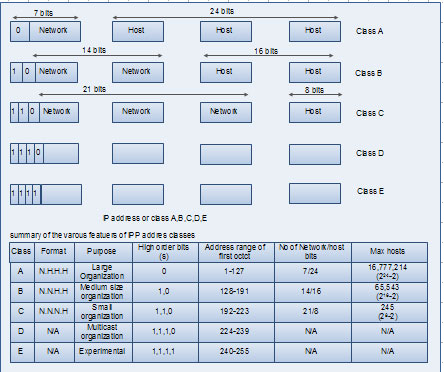• IP addressing supports five different address classes: A, B, C, D and E. Only classes A, Band C are available for commercial use.
• We can find the class of an address when given the address in binary notation or dotted decimal notation.
• If the address is given in binary notation, the first few bits can tell us the class of the address.
• If the address is given in dotted decimal notation, the first byte defines the class.
Class A addresses
1. Class A addresses are designed for large organizations with a large number of hosts or routers.
2. In this the first octet of the address identifies the network and the next three octets are used to identify the host.
3. The first bit of first octet is always 0 and the remaining 7 bits are used to identify the network address.
4. The next three octets i.e. 24 bits are used to identify the host.
5. The class support addresses from 0.0.0.0 to 0.255.255.255
6. The first block of network address starts with 1.0.0.0 and the last block of network address starts with 127.0.0.0.
7. As there are 7 bits in network address, 27 = 128 blocks of network address are possible. Out of these two network blocks are reserved. Hence total 126 address blocks are used.
8. Each network blocks can have 224--- 2 hosts i.e. 16,777,214 host address. Two addresses are less as one address is reserved for the broadcast address and one address is reserved for the network.
9. A block in class A is too large for almost any organization. This means most of the addresses in class A are wasted and are not used.
Class B address
1. The class B addresses are designed for medium sized organizations with tens of thousands of attached hosts or routers.
2. In this, the first two octets of the address identify the network and the next two octets identify the host within the network.
3. The first two bits (high order bits) of first octet are always 1,0. Thus the remaining 14 bits identify the network
4. The third and fourth octet i.e. 6 bits are used to identify the host.
5. The first network block of this class covers the addresses from 128.0.0.0 to 128.0.255.255 (net id 128.0). The last network block of this class covers addresses from 191.255.255.255 (net id 191.255)
6. The maximum number of network blocks in class B is 214 = 16384.
7 Each network block in class B can have 216--- 2 = 65,534 hosts.
8. A block in class B is also very large and most of the address in class B is also wasted.
Class C address
1. The class C addresses is designed for small organizations with a small number of attached hosts or routers.
2. In class C, the first three octets of address are used for network and the last octet is used to identify the host.
3. The first three bits of first octet are always set to 1, 1, 0.
4. The remaining 24 - 3 = 21 bits are used for network identification and only 8 bits are used for host.
5. In class C, 221 = 2,097,152 network blocks are possible.
6. Thus, each block in class C address can have 28 - 2 = 254 hosts.
7. The first block of network covers addresses from 192.0.0.0 to 192.0.0.255.
The last block of network covers the addresses form 223.255.255.0 to 223.255.255.255
8. The class C addresses are too less for many organizations as it supports only 254 hosts in a network.
Class D address
1. Class D addresses are used for multicast groups (multicasting)
2. The concept of division of octets into network id and host id does not apply to class D.
3. The first four bits of first octet in class D are always set to 1,1,1,0.
4. The address range is 224.0.0.0 to 239.255.255.255
Class E address
1. The Class E address are reserved for future use and are experimental.
2. The concept of network id and hostid does not apply on class E also.
3. The first four bits of first octet are always set to 1,1,1,1.
4. The address range for class E is 240.0.0.0 to 255.255.255.255.
Exercise
From the 32 bit IP address we can create dotted decimal notation by converting each byte to a decimal number between 0 and 255. We can also identity the class of an IP address by observing the first few bits of 1st byte of each IP address. The various examples are given in the table below.
We can also find the network address i.e. net id and host id for the IP address (dotted decimal notation) with help of class as shown below.



No comments:
Post a Comment